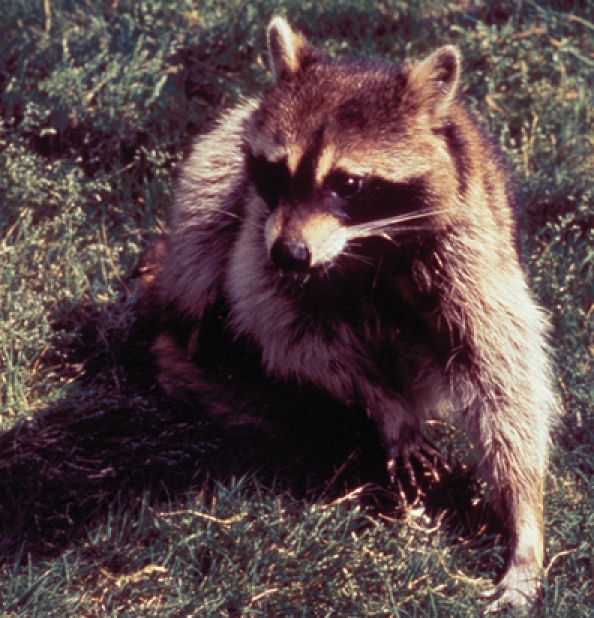Background and epidemiology: Baylisascaris procyonis is an intestinal roundworm commonly found in raccoon feces, with wide distribution across North America. The parasite can cause severe human neurological disease if ingested. Fifteen human infections have been reported since the first such case was documented in 1984. Last year, this roundworm was diagnosed in a young Canadian boy with autism after he came to hospital with symptoms consistent with encephalitis and the latter disease was reported to public health authorities.
Adult raccoons infected with Baylisascaris shed millions of eggs daily. The eggs take 2 weeks to mature into infective larvae; these larvae remain viable for years and can withstand harsh weather and decontamination. After ingestion, larvae migrate through the host's body tissues — the brain in particular, but also the eyes and viscera. Raccoons defecate in communal sites, called latrines, at the base of trees or on flat surfaces such as logs, tree stumps, decks and rooftops. Rain may wash feces off rooftops, to contaminate the soil below. Thus, the most common vehicles for ingestion include soil, wood, leaves, bark, sand and stones, in addition to direct ingestion of raccoon feces.
Young children with a history of geophagia are the likeliest to ingest Baylisascaris eggs. Of the infections documented, most patients have been males under 2 years of age or known to have a developmental disability or pica.1 Given the widespread geographic distribution of raccoons, human infection with raccoon roundworm is thought to be underrecognized.
Clinical management: Initial symptoms of Baylisascaris infection vary according to the site of larval migration in the body. Young children have presented with nonspecific symptoms including irritability, weakness, lethargy, deteriorated speech and behavioural changes, often accompanied by vision changes. Infection of the central nervous system with B. procyonis should be considered in the differential diagnosis of eosinophilic meningoencephalitis.2 It is important to inquire about exposure to raccoons, ingestion of environmental contaminants or a history of geophagia. Although the availability of serologic antigen testing is limited, its use can support diagnosis when Baylisascaris infection is suspected. Definitive diagnosis involves the identification of larvae in biopsy specimens.
Although no confirmed case has yet been successfully treated, management includes early administration of the antihelminthic medication albendazole along with corticosteroids2,3 and physical rehabilitation. When a patient suspected to be infected with roundworm, a contact history should be obtained; although multiple cases from a common exposure have not been documented, prophylactic treatment may be recommended on a case-by-case basis.
Contact with the patient is not a risk factor. People are an intermediate host to B. procyonis; it does not establish intestinal infection, and neither eggs nor larvae are shed into human feces.
Prevention: Raccoons are here to stay. There are several common-sense approaches to reduce raccoon populations in residential areas, prevent accumulations of raccoon feces and reduce the subsequent risk of infection with Baylisascaris. Animals' access to food sources such as garbage and domestic pet food should be denied through appropriate storage. Raccoons should not be intentionally fed or treated like domestic pets. Material that may contain raccoon feces should be removed; wear gloves and a facemask, and clean and treat exposed surfaces with boiling water. Susceptible populations such as young children and those with developmental disabilities should be discouraged from ingesting soil and other debris. Handwashing and good hygiene should always be encouraged, especially after outdoor play. Access to known raccoon latrine sites should also be restricted and decontaminated with help from the local public health unit.
Physicians should consider raccoon roundworm in the differential diagnosis of eosinophilic encephalitis, and conduct an appropriate history. Encephalitis is a reportable communicable disease; physicians should report cases promptly to their local public health unit. If infection with B. procyonis is suspected, the public health unit will send out a team of inspectors to complete a thorough environmental assessment.
Allison Chris Community Medicine Resident University of Toronto Toronto, Ont.
Figure.

Acknowledgments
I learned about the importance of during a rotation at Toronto Public Health; thanks are specifically due to Alan Grill, Jim Chan and Abimbola Forde.
Footnotes
Competing interests: None declared.
REFERENCES
- 1.Wise ME, Sorvillo FJ, Shafir SC, et al. Severe and fatal central nervous system disease in humans caused by Baylisascaris procyonis, the common roundworm of raccoons: a review of current literature. Microbes Infect 2005;7:317-23. [DOI] [PubMed]
- 2.Gavin PJ, Shulman ST. Raccoon roundworm (Baylisascaris procyonis). Pediatr Infect Dis J 2003;22:651-2. [DOI] [PubMed]
- 3.Park SY, Glaser C, Murray WJ, et al. Raccoon roundworm (Baylisascaris procyonis) encephalitis: case report and field investigation. Pediatrics 2000;106:E56. [DOI] [PubMed]


